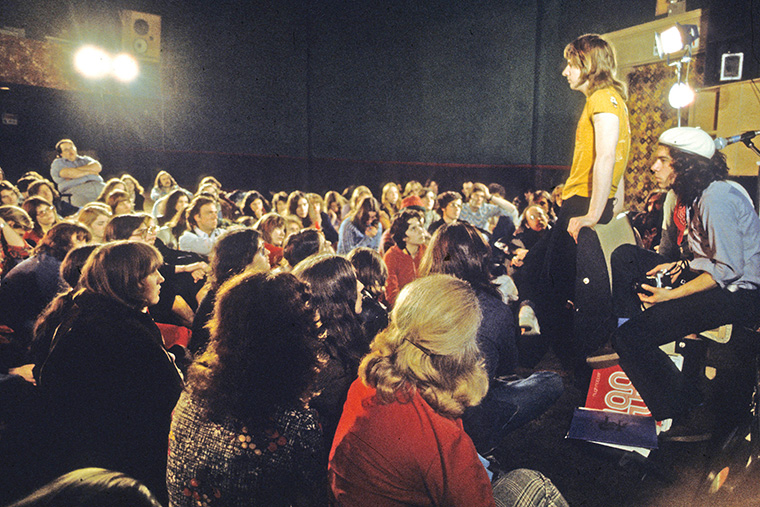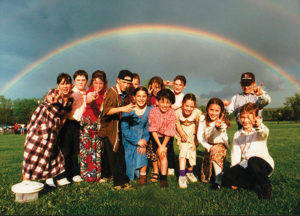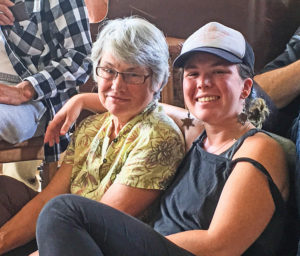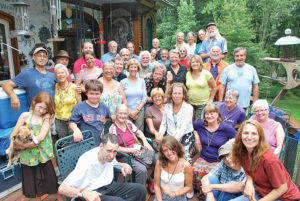By Daniel A. Brown

Renaissance Community founder, Michael Metelica at the height of his power and influence, 1974.
Thirty years after the demise of the Renaissance Community (see Communities #184, Fall 2019: “Whatever Happened to the Renaissance Community?”), its hundreds of former members are still trying to figure out what happened. There is no unified consensus and there probably never will be one. Renaissance lasted 20 years. I was there for 14 of them.
The fate of the Renaissance Community was tied to its charismatic founder, Michael Metelica, who founded the community at the age of 18 and within five years, had gained 300 dedicated acolytes and assets worth over a million dollars. At its height, the Renaissance Community owned properties in several towns, was featured in mainstream print and television media, operated over a dozen businesses and contracting companies, and often changed its identity to suit the needs of the times. It began in a treehouse and ended as a planned self-sufficient village on 80 acres in the bucolic village of Gill, Massachusetts.
The collapse was ugly but hardly unique. How the community fell follows a pattern that has played out in myriad others both large and small. A spiritual teacher has a vision to improve the world and through his love and wisdom, slowly gathers a coterie of followers. As the group expands, the teacher falls into the deadly trap of power, ego. and entitlement and begins to abuse and manipulate. The once-adoring followers become disgusted and leave the community. The remainder stays with the teacher until the bitter end when he/she is finally ousted or self-destructs. Were Shakespeare alive today, he would pen a play about it.
When Renaissance imploded, it did so in incremental stages. One small group would rebel against Metelica’s increasingly erratic behavior (he was increasingly addicted to cocaine and alcohol) and demand an end to his omnipotent leadership. They would be shouted down by his loyal majority and leave in frustration. A few years later, another small group would rise up with the same result. It was, thus, not unusual to have been both a supporter and a challenger of Metelica’s authority. This dynamic continued until only a tiny minority remained. Had we all risen up at once, Metelica would have been expelled early on and the Renaissance Community would most likely exist to this day.
In the course of his downward spiral, Metelica resorted to bullying, shaming, and in some isolated instances, physical violence towards those who challenged him. The conflict shook the community whose members were either divided into adversarial sides or refused to get involved. A common phrase the rebels heard was “Why don’t we all just love each other?,” which insidiously translated as “Shut up and don’t rock the boat.” As more fled, Metelica, aided by a few die-hard adherents, surrounded himself with guns and vicious pit bulls. The land itself degenerated into filth and squalor as nobody remaining had the energy or inspiration to continue the communal ethos.
Finally in 1988, Metelica was bribed to leave and never return. Although he took steps to clean himself up, he never apologized to those he hurt and would often express how we had “betrayed” him by leaving. There was little if any show of accountability. He died of colon cancer in 2003 at age 53.
One would think that with him gone, veterans of Renaissance would have flocked back to the Gill property to make their dream of spiritual fellowship come true. Nothing of the sort occurred. While we wax nostalgic at our annual reunions, deep inside, we haven’t forgotten the shadow side of our group and not all of it can be laid at the feet of Metelica.
And so, we surrendered into our new lives, raised our nuclear families, and found pleasure in having our own coffee pot and not having to attend endless meetings. Those who settled on the Gill land after Metelica’s departure had optimistic plans to revive the community. They were told by the battered survivors that no resurrection would be welcome. The Renaissance Community was done. The property in Gill has since reverted to private ownership.
We soon learned that while we had left the community, the community never had left us. For decades, I and my comrades have struggled with often-contradictory feelings of betrayal, regret, nostalgia, and romanticism.

Author Daniel A. Brown’s fulfilling career as an elementary school teacher is based in part on the lessons he learned about community while living at Renaissance.
I believe that the experience of our community rearranged the psychic DNA of all who were a part of it. Those of us who had joined in its early days went all in. We viewed our decision to cast our lot with Metelica as a lifetime commitment and planned to inhabit Renaissance for the rest of our lives. Such a powerful pledge resulted in a deeply emotional toll when that dream was overturned. Among our many losses was a sense of trust. Some have expressed shame or guilt for having followed a corrupted leader and wish they had left or called him out sooner than they did. Others have a hard time accepting that the power Metelica wielded was freely given to him by us. There will always be a continuing debate as to whether Michael Metelica was a true visionary who spiraled out of control or a manipulating con-artist from the get-go.
Another result was the discrediting and disbelieving of the spiritual precepts that formed the basis of Renaissance. If the leader was corrupt, then it stood to reason that so were his teachings. Therefore, while some of us have continued our spiritual path in other venues, others have discarded the concept of spirituality as just another airy-fairy pipe dream promoted by shysters.
The need to recover from and reflect upon the demise of the Renaissance Community began even as the community was still in existence. Reunions of former members began as early as five years before its end along with a monthly newsletter which included written testimonials and updated addresses. There was a great deal of bitterness expressed and many former friendships were broken between those who had either confronted or enabled Metelica. Strangely, many of the former included those who had been part of his inner circle.
The reunions are currently an annual event. Unfortunately, nobody who attends has much interest in confronting the issues that led to our downfall or to address some of the uglier accusations that have surfaced about Metelica. Not surprisingly, the forum has moved to a private chat site on Facebook where the conversations become quite volcanic at times. Two interpretations of Metelica and Renaissance hug the fringes; “We were the most spiritual, loving people ever” is countered by “We were brainwashed by an evil cult manipulator.” Our children, now in their 40s and 50s, occasionally weigh in, a few calling us to task for unpleasant experiences they had had. Others reminisce about the fun and adventures they enjoyed as kids living on the land with various surrogate mothers and fathers. Most of our colleagues, however, are content merely to chat with old friends or coo over group and individual photographs taken when we were young and idealistic.
I lived at Renaissance from age 20 through 34, joining after dropping out of college in 1970. Therefore, I re-entered the “real world” in early middle age. It took some adjusting for me to navigate renting a house, paying bills and taxes, opening a bank account, and negotiating insurance policies, not to mention the daily chores of working a job, cooking meals, and raising my son without the communal safety net. An additional adjustment was inhabiting a tiny rental in town after having 80 acres of rural beauty at my disposal.
Equally distressing―for Renaissance was a “spiritual” community―was a sudden lack of purpose. I had believed we were saving the world by our example of love and fellowship. Upon my departure, I found myself merely surviving.

The children of community members provide a vital perspective of Renaissance’s legacy.
Luckily, I was living with a woman who wasn’t associated with the group. She eased me through the transition and together, we created a summer program for children which created its own tribe using Native American rituals, structures, and values (supposedly, my partner had Native blood). I also returned to college to earn my teaching certificate. After she and I separated, I began a long and rewarding career as a teacher in the public school system. In both the camp and the school, I focused on the creation of community, valuing the children in my care both as individuals and as a collective family.
I feel no embarrassment about my behavior as a true believer in the community and I caution my friends not to be too hard on themselves. Growth is a process of trial and error, making mistakes and hopefully learning from them. Our communal endeavor grew out of the 1960s when there was no roadmap, guidebook, or “Spiritual Communities for Dummies” to help us along. Like most from that era, our community wanted to change the world but found that we were more human than could be admitted. Instead of berating myself over following a “failed dream,” I chalk it up as a painful, yet necessary growth experience that made me a better person. The spiritual values of Renaissance are now accepted in our broader society and I hold to them because they work and have aided me in my life to this day. As a wise friend recently observed, “The Guru had to fall in order for the seeds to spread.” How true. I believe that a vast majority of my communal friends are doing good, positive work in the world.
In retrospect, I’m glad the Renaissance Community came to an end. Had we remained in the community, our lives would have fallen into stagnant patterns of existence, hermetically sealed and institutionalized by the limits of our ideology. Worse, I would have been denied the rich and varied experiences I’ve enjoyed since my departure. Collectively, one of our peers observed that we of Renaissance have been “inoculated” against relinquishing our personal authority to charismatic leaders, no matter how enlightened. Myself, I have made my peace with Michael Metelica, appreciating what I learned from him while holding him accountable for his unsavory treatment of others.

Former members of the Renaissance Community still converge for annual reunions. The author, Daniel A. Brown is on the left in the blue shirt.
I remain open to living in a multi-generational community although I would be far more discerning and pragmatic in my choice. I would not be so naïve as to expect moral perfection among my peers nor would I abide any kind of charismatic leader. Fortunately, few communities nowadays are based on a solitary personality. They were a product of the 1960s when leaders were necessary to herd the cats of so many strong and diverse personalities. Communities that lacked a concerted focus soon relapsed into sloth, degradation, or mere boredom. Someone needed to be the vision-keeper at a time when such a concept was unknown.
As participants of the original communal movement advance into older ages, some see community as an alternative to assisted-living. This can be seen as a matter of survival or a return to the idealistic values of their youth. I would choose the latter and prefer to share whatever wisdom I have gained over the years with those of a younger generation. It would be a matter of giving back and perhaps helping others attain the worthwhile goal of creating community. And this time, doing it right.
Daniel A. Brown was born in New York City in 1950. He lived at the Brotherhood of the Spirit/Renaissance Community from 1970-1984 and is one of its archivists-history keepers. Since leaving Renaissance, Brown has been a classroom teacher, general aviation pilot, drum circle leader, published author, and exhibition artist and photographer. He currently lives in Taos, New Mexico with his wife, Lisa and dog, Cody. Brown’s artwork can be seen at www.intothewildblue.com.
Excerpted from the Spring 2020 edition of Communities (#186), “Picking Up the Pieces: New Beginnings.”
